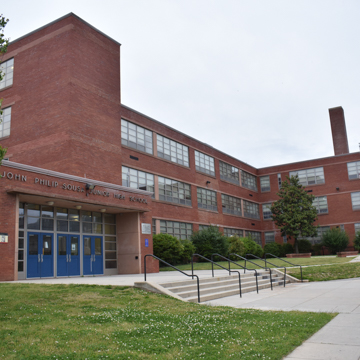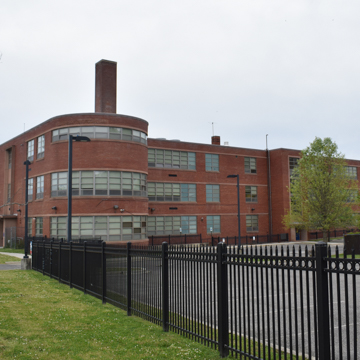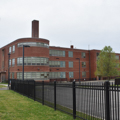The John Philip Sousa Junior High School is located in the Anacostia neighborhood in Southeast Washington, D.C., east of the Anacostia River. It serves as a symbol of the federal government's desegregation of public schools and the beginning of the modern civil rights movement.
Washington's first public school was built in 1865 and the first African American class graduated in 1877. Between 1896 and 1930, the city’s schools were firmly segregated, and since local schools depended upon congressional support, political change was especially difficult to accomplish. In 1954, the U.S. Supreme Court case Bolling v. Sharpe charged that segregation itself was discrimination and African American youth were guaranteed access to public education by the Fifth Amendment. The ruling thus allowed African American students to enroll and attend the John Philip Sousa Junior High School, the newly constructed all-white school.
The John Philip Sousa Junior High School was designed by Municipal Architect Merrel A. Coe, who was also responsible for the Wilson, Roosevelt, and Coolidge high schools and several buildings at the National Zoo. Built into a low slope, the brick and glass building sits a few feet back from Ely Place and faces south to the tree-lined Fort Dupont Park. The building is organized around two distinctive sections that vary from one to five stories; they also feature different aesthetic approaches with the east section following a modern streamlined architectural style and the west side presenting a more toned-down and basic elevation. The moderne section contains the classrooms, administrative offices, and library, while the rectangular section contains the gymnasium and auditorium. The asymmetrical building has a flat roof and metal casement windows; the brick fashions a common bond brick pattern.
The entrance to the building is located in the middle of the L-shaped moderne section. It also features sets of windows that vary in width from two to five windows to emphasize the horizontality of the design. The two-story rectangular building contains the gymnasium and auditorium. Lines of single windows divided by brick expanse characterize the exterior of the modern portion of the school. Recent renovation efforts have involved covering windows with white metal mesh or opaque glass, yet preserving the original casement frames.
Notable school alumni includes Frederick D. Gregory, the first African American astronaut to command a space shuttle mission. The John Philip Sousa Junior High School building was listed as a National Historical Landmark in 2001. It is currently a public middle school.
References
"John Philip Sousa Junior High School," DC Historic Sites. Accessed March 28, 2020. https://historicsites.dcpreservation.org/.
"Merrel A. Coe, 68, Dead; Architect for District." The Washington Post, February 18, 1965.
Salvatore, Susan Cianci. "John Philip Sousa Junior High School," District of Columbia. National Historic Landmark Nomination Form, 2001. National Park Service, U.S. Department of the Interior, Washington, D.C.
Torres, John A., and Sarah Betsy Fuller. Desegregating Schools: Brown v. Board of Education. New York: Enslow Publishing, 2017.
Wiley, Amber. "The Dunbar High School Dilemma: Architecture, Power, and African American Cultural Heritage." Buildings & Landscapes 20, no. 1 (March 2013): 95-128.




